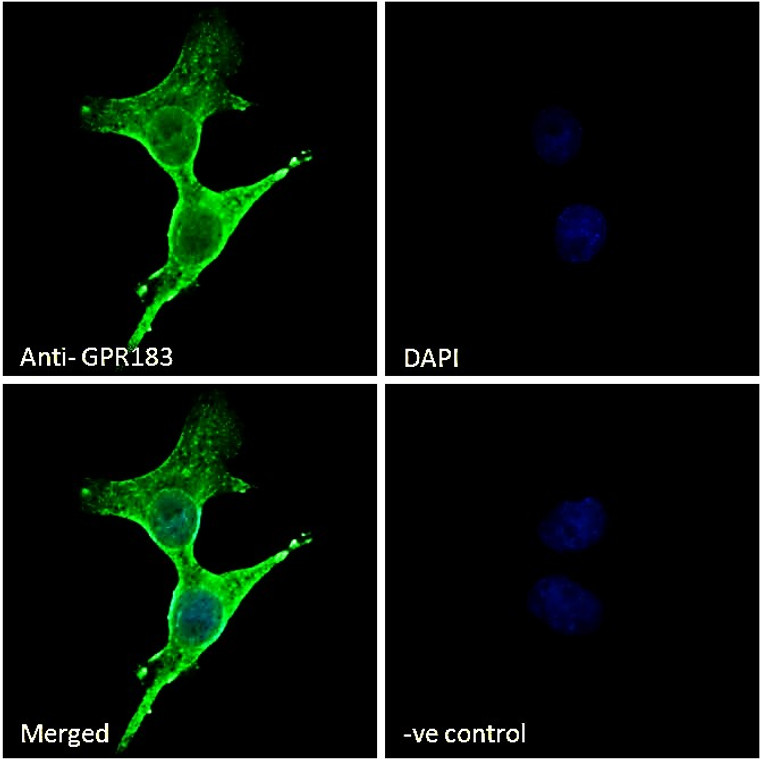| Host: |
Goat |
| Applications: |
Pep-ELISA/IF/FC |
| Reactivity: |
Human |
| Note: |
STRICTLY FOR FURTHER SCIENTIFIC RESEARCH USE ONLY (RUO). MUST NOT TO BE USED IN DIAGNOSTIC OR THERAPEUTIC APPLICATIONS. |
| Short Description: |
Goat polyclonal antibody anti-GPR183 (Internal) is suitable for use in ELISA, Immunofluorescence and Flow Cytometry research applications. |
| Clonality: |
Polyclonal |
| Conjugation: |
Unconjugated |
| Isotype: |
IgG |
| Formulation: |
0.5 mg/ml in Tris saline, 0.02% sodium azide, pH7.3 with 0.5% bovine serum albumin. NA |
| Purification: |
Purified from goat serum by ammonium sulphate precipitation followed by antigen affinity chromatography using the immunizing peptide. |
| Concentration: |
0.5 mg/mL |
| Dilution Range: |
IF-Strong expression of the protein seen in A431 and U2OS cells. 10µg/mlFC-Flow cytometric analysis of A431 cells. 10ug/mlELISA-antibody detection limit dilution 1:32000. |
| Storage Instruction: |
Store at-20°C on receipt and minimise freeze-thaw cycles. |
| Gene Symbol: |
GPR183 |
| Gene ID: |
1880 |
| Uniprot ID: |
GP183_HUMAN |
| Immunogen Region: |
Internal |
| Accession Number: |
NP_004942.1 |
| Immunogen Sequence: |
NKIKRIEHAK |
| Function | G-protein coupled receptor expressed in lymphocytes that acts as a chemotactic receptor for B-cells, T-cells, splenic dendritic cells, monocytes/macrophages and astrocytes. Receptor for oxysterol 7-alpha,25-dihydroxycholesterol (7-alpha,25-OHC) and other related oxysterols. Mediates cell positioning and movement of a number of cells by binding the 7-alpha,25-OHC ligand that forms a chemotactic gradient. Binding of 7-alpha,25-OHC mediates the correct localization of B-cells during humoral immune responses. Guides B-cell movement along the B-cell zone-T-cell zone boundary and later to interfollicular and outer follicular regions. Its specific expression during B-cell maturation helps position B-cells appropriately for mounting T-dependent antibody responses. Collaborates with CXCR5 to mediate B-cell migration.probably by forming a heterodimer with CXCR5 that affects the interaction between of CXCL13 and CXCR5. Also acts as a chemotactic receptor for some T-cells upon binding to 7-alpha,25-OHC ligand. Promotes follicular helper T (Tfh) cells differentiation by positioning activated T-cells at the follicle-T-zone interface, promoting contact of newly activated CD4 T-cells with activated dendritic cells and exposing them to Tfh-cell-promoting inducible costimulator (ICOS) ligand. Expression in splenic dendritic cells is required for their homeostasis, localization and ability to induce B- and T-cell responses: GPR183 acts as a chemotactic receptor in dendritic cells that mediates the accumulation of CD4(+) dendritic cells in bridging channels. Regulates migration of astrocytes and is involved in communication between astrocytes and macrophages. Promotes osteoclast precursor migration to bone surfaces. Signals constitutively through G(i)-alpha, but not G(s)-alpha or G(q)-alpha. Signals constitutively also via MAPK1/3 (ERK1/2). |
| Protein Name | G-Protein Coupled Receptor 183Epstein-Barr Virus-Induced G-Protein Coupled Receptor 2Ebi2Ebv-Induced G-Protein Coupled Receptor 2Hebi2 |
| Database Links | Reactome: R-HSA-373076Reactome: R-HSA-418594 |
| Cellular Localisation | Cell MembraneMulti-Pass Membrane Protein |
| Alternative Antibody Names | Anti-G-Protein Coupled Receptor 183 antibodyAnti-Epstein-Barr Virus-Induced G-Protein Coupled Receptor 2 antibodyAnti-Ebi2 antibodyAnti-Ebv-Induced G-Protein Coupled Receptor 2 antibodyAnti-Hebi2 antibodyAnti-GPR183 antibodyAnti-EBI2 antibody |
Information sourced from Uniprot.org
12 months for antibodies. 6 months for ELISA Kits. Please see website T&Cs for further guidance







